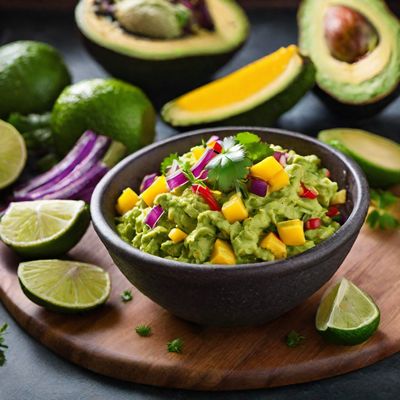
Ingredient
Canned or jarred pineapple
Preserved Sweetness: Unveiling the Versatility of Canned or Jarred Pineapple
Canned or jarred pineapple is a preserved form of the tropical fruit, known for its vibrant yellow color, juicy texture, and sweet flavor. It can be used in a variety of dishes, including stir-fries, salads, desserts, and cocktails, providing a refreshing and tropical twist to the overall flavor profile.
Origins and history
Pineapples are native to South America, particularly Brazil and Paraguay, and have a long history dating back to ancient times. They were highly valued by indigenous tribes for their medicinal properties and were later introduced to Europe by Christopher Columbus. Today, pineapples are cultivated in tropical regions worldwide, with countries like Thailand, the Philippines, and Costa Rica being major producers.
Nutritional information
Canned or jarred pineapple is a good source of vitamin C, manganese, and dietary fiber. It is also low in calories and fat, making it a guilt-free addition to various recipes. However, it is important to note that canned pineapple may contain added sugars, so it is advisable to check the label for any additional ingredients or opt for varieties packed in natural juice.
Allergens
Individuals with a known allergy to pineapple should avoid consuming canned or jarred pineapple. Additionally, some people may experience digestive discomfort or allergic reactions due to the bromelain enzyme present in pineapples. It is recommended to consume pineapple in moderation and seek medical advice if any adverse symptoms occur.
How to select
When selecting canned or jarred pineapple, look for varieties that are packed in their own juice or water, without any added sugars or syrups. The pineapple should appear bright and vibrant, with no signs of discoloration or spoilage. Opt for reputable brands and check the expiration date to ensure freshness.
Storage recommendations
To maintain the freshness and quality of canned or jarred pineapple, store it in a cool, dry place away from direct sunlight. Once opened, transfer any unused pineapple to a clean, airtight container and refrigerate it. Consume within a few days to enjoy its optimal taste and texture.
How to produce
Growing pineapples at home can be a challenging task, as they require a tropical climate and a long growing season. However, pineapple tops can be rooted in water and transferred to a pot or garden, allowing for a decorative plant to be grown. While it may not produce fruit, it can still be a rewarding experience for gardening enthusiasts.
Preparation tips
Canned or jarred pineapple can be used in a variety of ways. It can be added to stir-fries, pizzas, or grilled dishes to provide a sweet and tangy contrast. It is also a popular ingredient in tropical desserts like pineapple upside-down cake or fruit salads. For a refreshing twist, blend canned pineapple with ice and other fruits to create delicious smoothies or cocktails.
Culinary uses
Canned or jarred pineapple is a versatile ingredient that can be found in a wide range of cuisines, including Asian, Caribbean, and Hawaiian. It is commonly used in dishes like sweet and sour chicken, pineapple fried rice, or piña coladas. Its sweet and tangy flavor adds a tropical touch to both savory and sweet recipes.
Availability
Canned or jarred pineapple is widely available in grocery stores and supermarkets worldwide. It is commonly cultivated in tropical regions, including Southeast Asia, South America, and Hawaii.
More ingredients from this category

Canned or jarred peach
Preserved Delight: Exploring the World of Canned or Jarred Peaches

Canned or jarred table grape
Preserved Grape Delight

Canned or jarred apple
Preserved Delight: Unlocking the Sweetness of Canned or Jarred Apples

Canned or jarred pear
Preserved Perfection

Canned or jarred apricot
The Sweet and Tangy Delight

Canned or jarred sweet cherry
Preserved Sweet Delicacy: Canned or Jarred Sweet Cherry

Canned or jarred plum
Preserved Sweet Gems

Canned or jarred sour cherry
The Tart Delight of Canned or Jarred Sour Cherries

Canned or jarred mandarin
The Tangy Citrus Delight

Canned or jarred cranberry
The Versatile Berry: Canned or Jarred Cranberry

Canned or jarred mixed fruit
A Burst of Fruity Delight
Recipes using Canned or jarred pineapple » Browse all

Filipino-style Salade Rachel
Tropical Twist: Filipino-inspired Salade Rachel

Polynesian-inspired Chicken Breast Kotlet
Tropical Paradise Chicken Delight

Caribbean Caesar Salad
Tropical Twist Caesar Salad

Vanuatuan-style Stuffed Bread Rolls
Tropical Delight: Vanuatuan Stuffed Bread Rolls

Homemade Sweet and Spicy Jezebel Sauce
Tangy Delight: Sweet and Spicy Jezebel Sauce

Caribbean Style Falafel
Tropical Twist Falafel Delight

Chinese Buddhist Miang Kham
Enlightened Leaf Wraps: Chinese Buddhist Miang Kham

Brazilian-style Guacamole
Tropical Avocado Salsa

Tacos al Pastor
Fast and Flavorful Tacos al Pastor: A Mexican Twist on Fast Food

Ecuadorian Baicoli with a Tropical Twist
Tropical Biscotti: A Taste of Ecuadorian Baicoli

Floribbean Zbornjak
Tropical Fusion: Floribbean Zbornjak

Hawaiian-style Mole Negro
Tropical Delight: Hawaiian-inspired Mole Negro